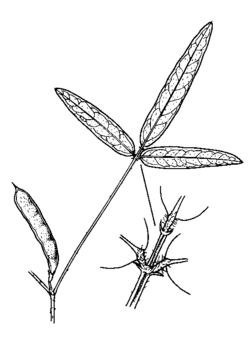Glycine stenophita B.E.Pfeil & Tindale APNI* 
Description: Scrambler or twiner; stems non-stoloniferous, with white hairs.
Leaves pinnately 3-foliolate, rachis to 7 mm long, strongly dimorphic; upper leaflets narrow-ovate, narrow-elliptic or linear, to 8 cm long and 8 mm wide, apex acute; lower leaflets shorter and broader, apex obtuse and sometimes emarginate; upper surface with sparse appressed white hairs, or glabrous; lower surface with sparse appressed to ascending white hairs; stipels to 1 mm long.
Racemes to 10 cm long. Calyx sparsely hairy with white hairs; sinus between upper teeth 0.25–0.5 mm long. Standard 7–8 mm long; pink, pale purple or purple.
Chasmogamous pods not seen; cleistogamous pods axillary, initially straight but sometimes twisting after dehiscence, to 1.5–3 cm long, 3–4 mm wide, without purple flecks, sparsely hairy; seeds usually 4–6; surface rough, ± mottled. Diploid, 2n=40.
Flowering: Flowering time unknown.
Distribution and occurrence: On the ranges and Slopes north from Condobolin district.
NSW subdivisions: NWS, NWP
Other Australian states: Qld
There is considerable overlap in morphological characters of this species and G. pacifica ms.
Text by B.E. Pfeil & M.D. Tindale
Taxon concept:
APNI* Provides a link to the Australian Plant Name Index (hosted by the Australian National Botanic Gardens) for comprehensive bibliographic data
***The AVH map option provides a detailed interactive Australia wide distribution map drawn from collections held by all major Australian herbaria participating in the Australian Virtual Herbarium project.
|


